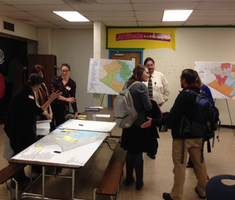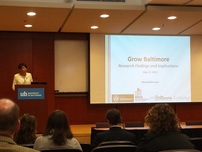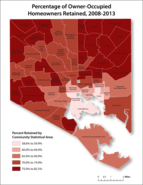 South Baltimore Gateway Master Plan
Following
a presentation to the Local Development Council (LDC) on July 30th and
a briefing to the Planning Commission on August 6th, the South
Baltimore Gateway Master Plan draft is now available for public comment.
Beginning today, August 17th, the Planning Department invites you to
provide feedback on the contents of the plan during a 30 day public review
period. This draft plan is the product of an extensive two-year planning process that produced a set of shared goals and priorities for the planning area, depicted in the map below.
Planning and their consultant the
Hatcher Group will incorporate feedback received along with other edits
currently underway. The goal is for Planning Commission to adopt a final
version of the Plan in October, following the public comment period and one
last public meeting in early September.
Click on map to enlarge.
 The South
Baltimore Gateway Master Plan, led by the Department of Planning, is the
product of community stakeholders’ and City agencies’ input on a long-range
vision for resource allocation and policy actions in the Horseshoe Casino
Impact Area. Fourteen neighborhoods and two industrial zones in South Baltimore
surrounding the Middle Branch will benefit from Local Impact Grant (LIG) funds
resulting from revenues of the casino operations. For more background
information on the plan process, working groups, and maps, please visit the South Baltimore Gateway Master
Plan website.
Planning staff and their consultants conducted an
in-depth review of agency work group reports to identify common themes, resolve any conflicts and identify policy implications. Community input sessions gave residents and
other stakeholders a chance to contribute their ideas and concerns on these
topics.
 The
draft Plan is the result of community and stakeholder input, gathered over a
series of eight public meetings, on key topic areas including Housing and Land Use;
Education, Workforce and Economic Development; and Transportation,
Infrastructure and Energy. The Plan builds upon already-adopted Master Plans and previous planning efforts in neighborhoods including Cherry Hill, Key Highway
Waterfront, Locust Point, Middle Branch, Sharp-Leadenhall, and Westport/Mount
Winans/Lakeland.
As
the Master Plan moves towards final approval, the LDC will translate the Goals,
Strategies and Recommendations, as outlined in the Plan’s “Implementation
Matrix,” into a Multi-Year Spending Plan for Local Impact Grant (LIG) funds.
The planned October Planning Commission vote will roughly coincide with the release
of the City's Draft Spending Plan for FY17 LIG funds to the LDC, which is envisioned to
align with the multi-year plan.
|
  GROW BALTIMORE:
Findings
Release and Implications
 On May 21, 2015 Grow Baltimore, Mayor
Stephanie Rawlings-Blake’s initiative aimed at growing the city by 10,000
families, reached a major milestone - the release of the Baltimore Neighborhood Indicators
Alliance study that, for the first time, explores why people move out of Baltimore. What the city experiences on an annual basis
is “churn,” with new residents entering the city and others moving away. The study examined population changes and
migration trends within the city to see where, and potentially why, people are
moving.
For the first time in generations the
City has seen population gain – The US Census Bureau estimates Baltimore’s
population at 622,793 in 2014, or a 0.3 percent increase over the 2010 count of
620,961. The map below shows a new
community indicator, developed by BNIA, which measures the percentage of
owner-occupied households that remain under the same ownership for a five year
period. Flow Baltimore, is
a visualization tool that helps community stakeholders discover trends of where
residents from their communities are moving.
|
 Many Baltimore residents are drawn to
the surrounding counties in Maryland, specifically around the time their
children reach Middle School age. BNIA surveyed many of these citizens that
moved to determine “Push” and “Pull” factors. In many cases, those that left
the city did so based on school choice.
(Click on map to enlarge.)
|
Based on BNIA’s research and
additional focus groups, Live Baltimore developed a website portal called “Way to Stay”, targeted
at family retention by providing the necessary resources for families to make a
well-researched decision before moving.
Way to Stay features three key areas:
Schools, Space, and Support. In addition to Live Baltimore’s information
on neighborhoods, buying and renting, and financial incentives, Way to Stay contains
maps of the city by public school zone and features 17 enhanced school profiles
ranked by leadership, facility quality, and parent rankings.
For its part, the Department of Planning supports the Grow
Baltimore initiative by continually tracking residential development. Since 2010, the city has added 10,784 new
residential units. The Department also closely
tracks the annual population estimates released by the US Census Bureau.
Follow the City’s progress at #GrowBaltimore |